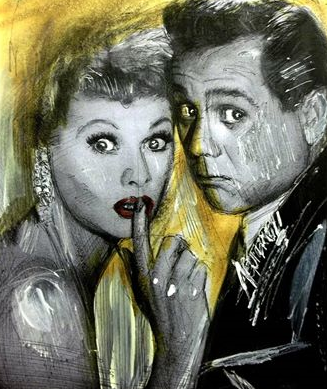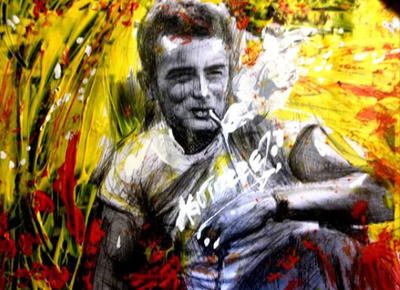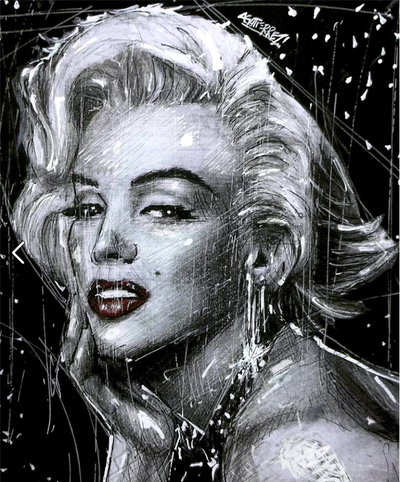The 1950's
Now that we know a little more about Vilma and the direction of this blog, let’s step back in time to take a glimpse at the world in the nostalgic past of the 1950's:
It was a time without the Internet, Twitter, Facebook and Smartphones. Not everyone had a home phone or even their own television yet. How did people ever communicate? People simply wrote letters--many letters, sent telegrams or most often just came to visit you at your own home to talk face to face.
It was considered a safe and peaceful decade. World War II was over, the main worry people had was the escalating “Cold War” with Russia and the proliferation of Communism throughout the world. This gave rise to the Korean War which began in 1950, often referred to as the “Forgotten War”, which America was in against the North Korean Communists.
Boomtown
During World War II, Los Angeles grew as the epicenter for production of aircraft, war supplies and ammunitions. By 1950, Los Angeles was an industrial and financial giant created by war production and migration. Los Angeles assembled more cars than any other city than Detroit and became the national capital for the production of motion pictures, radio programs and television programs. Construction boomed as tract houses were built in ever expanding suburban communities. America itself was in an economic boom and jobs were in abundance.
Family Life
Women were generally not career minded, the goal for a young girl just out of school was to find a man like her dear old dad and get married. It was considered the age of the “Nuclear Family”: The three bedroom house, 2.3 kids, and a family dog. Dad was the one and only breadwinner while Mom provided a stable, nurturing home for the children. Americans attended church regularly, religion and faith were valued and it was considered a morally conscious society. Teenagers spent most of their time with their families, but when spending time with their friends, cars were the “hang outs” as they cruised through the town.
The Great American Car Culture
The decade of the 1950’s began with 25 million registered automobiles on the road, most of which predated World War II and were in poor condition. No automobiles or parts were produced during the war due to rationing and restrictions. However by 1950 most factories had made the changeover to a consumer-based economy, which birthed the great American car culture of the 1950’s.
During this time the city of Los Angeles continued to spread out, particularly with the development of the San Fernando Valley and the continued improvement of the freeway system constructed in the wartime of the 1940s, which was originally designed for military transport.
Los Angeles became a city built around the automobile. Everyone talked cars, discussed the new models and knew the specifics like horsepower, features and of course, the cost. It was Detroit and Los Angeles who were the major car builders in the 1950's. They gave us style, impressiveness and even pizzazz! The American car screamed out the country's optimism and enthusiasm in a decade of hope. Car manufacturers did everything in their power to excite buyers to flock to their new car showrooms. We wanted it bigger, taller, more powerful and drenched with chrome.
The dawning of the Space Age and the Space Race were reflected in contemporary American automotive styles. Large tailfins, graceful designs reminiscent of rockets and radio antennas that imitated Sputnik 1 were common. A new generation of service businesses focusing on customers with their automobiles sprang up during the decade, full service gas stations, drive-through or drive- in restaurants and the classic drive-in theaters.
The hottest and finest cars ever to be built came out of the 1950’s, from the Ford Mustang, to the Cadillac Convertible and Chevy Corvette, these are the likes of which will never, ever be produced again in any of our lifetimes. And let’s not forget the Hot Rods and Muscle Cars popularized in movies which made James Dean famous, and all 100% made in America like most things were in the 1950’s.
The Music
After WWII, the 1950's was a time of change and Rock n’ Roll was the newest sound on the horizon. America was about to embark on a musical voyage that would alter the face of music. New recording technologies such as the 45 RPM single, electric guitars, electric bass and jukeboxes allowed a change in the way people created and listened to music. This decade was a time of innovation that impacted everything that we listen to on the radio today.
The 1950's saw the growth of Rock 'n' Roll and Rockabilly. The term "Rockabilly" was coined because it sounds like a combination of country and R&B music with rock influences. Artists that were popular in the rockabilly genre were Buddy Holly, Jerry Lee Lewis and Gene Vincent.
Rhythm & Blues (R&B) and Rock 'n' Roll popularized "black" music. Many African-American musicians rose to fame and enjoyed great success. Elvis Presley is thought to be the "King of Rock 'n' Roll", he originally wanted to market "black music" to white audiences, especially with his Gospel roots. Elvis was more successful in this endeavor than any other artist of the time and he epitomized the Rock 'n' Roll style. Other popular R & B artists were B. B. King, Fats Domino, Ray Charles and Etta James.
Traditional Pop music of the 1950's is the music that was popular before rock music came into the mainstream in the middle of the 1950’s. Most of the traditional pop artists of the 1950's sang pop standards, they would take the older well-known songs and put their own individual style into it. Some examples of traditional pop artists were Perry Como, Tony Bennett, Nat King Cole, Ella Fitzgerald and Patti Page. This genre was greatly influenced by jazz, swing and big band standards.
The most popular musicians in this genre also translated well onto television and would sometimes have their own TV variety shows or music specials. Some of the most popular artists who crossed over to Television were Dean Martin, Frank Sinatra, Peggy Lee, and Doris Day.
As one can see, this was a very unique and transitional time for America. It is interesting that the history of this era has become 'cool' again and has been making a comeback. You can find a huge market for the clothing as many youth are dressing in signature hairstyles and the fashions of the day! I hope this little website does its best at continuing to promote and inspire the nostalgia of the 1950's.
It was a time without the Internet, Twitter, Facebook and Smartphones. Not everyone had a home phone or even their own television yet. How did people ever communicate? People simply wrote letters--many letters, sent telegrams or most often just came to visit you at your own home to talk face to face.
It was considered a safe and peaceful decade. World War II was over, the main worry people had was the escalating “Cold War” with Russia and the proliferation of Communism throughout the world. This gave rise to the Korean War which began in 1950, often referred to as the “Forgotten War”, which America was in against the North Korean Communists.
Boomtown
During World War II, Los Angeles grew as the epicenter for production of aircraft, war supplies and ammunitions. By 1950, Los Angeles was an industrial and financial giant created by war production and migration. Los Angeles assembled more cars than any other city than Detroit and became the national capital for the production of motion pictures, radio programs and television programs. Construction boomed as tract houses were built in ever expanding suburban communities. America itself was in an economic boom and jobs were in abundance.
Family Life
Women were generally not career minded, the goal for a young girl just out of school was to find a man like her dear old dad and get married. It was considered the age of the “Nuclear Family”: The three bedroom house, 2.3 kids, and a family dog. Dad was the one and only breadwinner while Mom provided a stable, nurturing home for the children. Americans attended church regularly, religion and faith were valued and it was considered a morally conscious society. Teenagers spent most of their time with their families, but when spending time with their friends, cars were the “hang outs” as they cruised through the town.
The Great American Car Culture
The decade of the 1950’s began with 25 million registered automobiles on the road, most of which predated World War II and were in poor condition. No automobiles or parts were produced during the war due to rationing and restrictions. However by 1950 most factories had made the changeover to a consumer-based economy, which birthed the great American car culture of the 1950’s.
During this time the city of Los Angeles continued to spread out, particularly with the development of the San Fernando Valley and the continued improvement of the freeway system constructed in the wartime of the 1940s, which was originally designed for military transport.
Los Angeles became a city built around the automobile. Everyone talked cars, discussed the new models and knew the specifics like horsepower, features and of course, the cost. It was Detroit and Los Angeles who were the major car builders in the 1950's. They gave us style, impressiveness and even pizzazz! The American car screamed out the country's optimism and enthusiasm in a decade of hope. Car manufacturers did everything in their power to excite buyers to flock to their new car showrooms. We wanted it bigger, taller, more powerful and drenched with chrome.
The dawning of the Space Age and the Space Race were reflected in contemporary American automotive styles. Large tailfins, graceful designs reminiscent of rockets and radio antennas that imitated Sputnik 1 were common. A new generation of service businesses focusing on customers with their automobiles sprang up during the decade, full service gas stations, drive-through or drive- in restaurants and the classic drive-in theaters.
The hottest and finest cars ever to be built came out of the 1950’s, from the Ford Mustang, to the Cadillac Convertible and Chevy Corvette, these are the likes of which will never, ever be produced again in any of our lifetimes. And let’s not forget the Hot Rods and Muscle Cars popularized in movies which made James Dean famous, and all 100% made in America like most things were in the 1950’s.
The Music
After WWII, the 1950's was a time of change and Rock n’ Roll was the newest sound on the horizon. America was about to embark on a musical voyage that would alter the face of music. New recording technologies such as the 45 RPM single, electric guitars, electric bass and jukeboxes allowed a change in the way people created and listened to music. This decade was a time of innovation that impacted everything that we listen to on the radio today.
The 1950's saw the growth of Rock 'n' Roll and Rockabilly. The term "Rockabilly" was coined because it sounds like a combination of country and R&B music with rock influences. Artists that were popular in the rockabilly genre were Buddy Holly, Jerry Lee Lewis and Gene Vincent.
Rhythm & Blues (R&B) and Rock 'n' Roll popularized "black" music. Many African-American musicians rose to fame and enjoyed great success. Elvis Presley is thought to be the "King of Rock 'n' Roll", he originally wanted to market "black music" to white audiences, especially with his Gospel roots. Elvis was more successful in this endeavor than any other artist of the time and he epitomized the Rock 'n' Roll style. Other popular R & B artists were B. B. King, Fats Domino, Ray Charles and Etta James.
Traditional Pop music of the 1950's is the music that was popular before rock music came into the mainstream in the middle of the 1950’s. Most of the traditional pop artists of the 1950's sang pop standards, they would take the older well-known songs and put their own individual style into it. Some examples of traditional pop artists were Perry Como, Tony Bennett, Nat King Cole, Ella Fitzgerald and Patti Page. This genre was greatly influenced by jazz, swing and big band standards.
The most popular musicians in this genre also translated well onto television and would sometimes have their own TV variety shows or music specials. Some of the most popular artists who crossed over to Television were Dean Martin, Frank Sinatra, Peggy Lee, and Doris Day.
As one can see, this was a very unique and transitional time for America. It is interesting that the history of this era has become 'cool' again and has been making a comeback. You can find a huge market for the clothing as many youth are dressing in signature hairstyles and the fashions of the day! I hope this little website does its best at continuing to promote and inspire the nostalgia of the 1950's.


